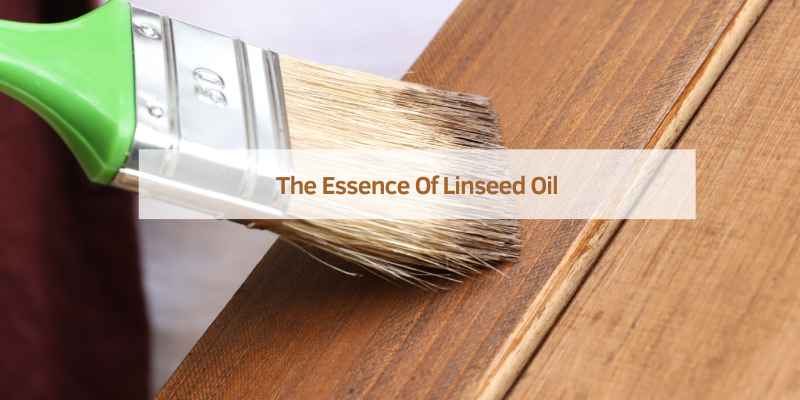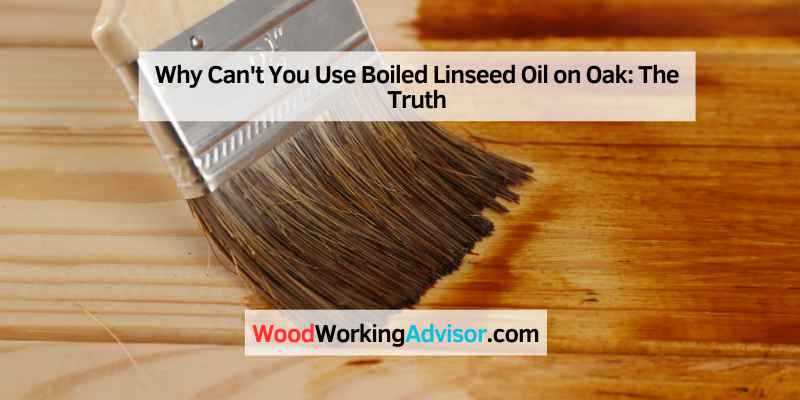Boiled linseed oil reacts with tannins in oak, causing discoloration and an uneven finish. Oak contains high tannin levels that can lead to splotchy and darkened areas when exposed to boiled linseed oil.
This reaction compromises the natural beauty of oak wood and can result in an undesirable appearance. To preserve the quality and appearance of oak furniture or surfaces, it is recommended to use alternative finishing oils that do not react negatively with oak’s tannins, such as tung oil or Danish oil.
By selecting a suitable finishing oil, you can enhance the oak’s natural beauty while protecting it from damage and discoloration.
The Essence Of Linseed Oil
Origins And Properties
Linen, a natural fiber derived from the flax plant, serves as the primary source of linseed oil. This oil, also known as flaxseed oil, is extracted through a process of pressing the seeds of the flax plant. Its inherent properties include polymerization, which enables it to cure when exposed to oxygen, forming a protective layer.
Common Uses In Wood Finishing
Linseed oil has been a staple in wood finishing for centuries due to its remarkable ability to penetrate the grain and enhance the natural beauty of the wood. It is commonly utilized to enrich the appearance of furniture, flooring, and cabinetry, providing a glossy finish and protecting the wood from moisture and wear.

Characteristics Of Oak Wood
Oak is a popular choice for furniture and flooring due to its durability and strength. The wood features a prominent grain pattern and a distinctive golden-brown hue. Oak is also resistant to moisture and rot, making it an ideal material for both indoor and outdoor applications.
Unique Features
Oak wood is known for its distinctive grain pattern, which adds a touch of natural beauty and character to any piece of furniture. The wood’s high density and hardness make it exceptionally durable, capable of withstanding heavy use and wear over time. Additionally, oak’s natural resistance to insect infestations further enhances its longevity.
Challenges In Finishing
While oak wood offers numerous benefits, it presents challenges when it comes to finishing. Due to its open grain structure, oak tends to absorb finishes unevenly, resulting in blotchy or streaky appearances. Moreover, the natural tannins in oak can react with certain finishes, causing undesirable discoloration.
Chemistry Behind Boiled Linseed Oil And Oak Interaction
Boiled linseed oil reacts poorly with oak due to its high tannin content, causing a sticky finish. The chemical interaction between the two leads to a problematic outcome, making it unsuitable for use on oak surfaces.
Oil Penetration Issues
Boiled Linseed Oil is a popular wood finish because of its ability to penetrate the wood and provide a protective layer. However, when it comes to oak, the oil penetration can be an issue. Oak has a tight grain structure that makes it difficult for the oil to penetrate deeply. As a result, the oil tends to stay on the surface, which can lead to a sticky and tacky finish.
Adhesion Complications
Another issue with using Boiled Linseed Oil on oak is adhesion complications. Oak contains a high level of tannins that can react with the oil and cause it to dry slowly. This reaction can also lead to a poor adhesion between the oil and the wood, causing the finish to peel off over time.
In conclusion, while Boiled Linseed Oil is a great wood finish for many types of wood, it is not recommended for oak. The tight grain structure of oak makes it difficult for the oil to penetrate deeply, which can lead to oil penetration issues. Additionally, the high level of tannins in oak can cause adhesion complications, leading to a poor finish. It is recommended to use other finishes, such as polyurethane or tung oil, for oak to ensure a long-lasting, quality finish.
Historical Misconceptions
Boiled linseed oil is not recommended for use on oak due to a historical misconception. It can cause discoloration and prevent the wood from properly absorbing other finishes.
Ancient Practices
Historically, boiled linseed oil was used on oak due to its perceived benefits.
Modern Understanding
However, modern research has shown that boiled linseed oil can harm oak.
Alternative Treatments For Oak
When it comes to treating oak, boiled linseed oil is not recommended. However, there are alternative treatments that can be used to protect and enhance the beauty of oak wood. In this section, we will explore some of the recommended oils and preparation techniques for treating oak.
Recommended Oils
If you are looking for a suitable oil treatment for oak, there are several options to consider. These oils not only nourish the wood but also provide protection against moisture, staining, and UV damage. Here are some recommended oils for treating oak:
- Tung oil: Tung oil is a popular choice for oak as it penetrates deep into the wood, enhancing its natural beauty and providing excellent durability. It dries to a matte finish and is resistant to water and heat.
- Danish oil: Danish oil is a blend of varnish and oil that offers good protection and brings out the rich tones of oak. It provides a satin finish and is easy to apply.
- Teak oil: Although primarily used for teak wood, teak oil can also be used on oak. It provides a rich, warm finish and protects against moisture and mildew.
Preparation Techniques
Before applying any oil treatment, proper preparation is crucial to ensure optimal results. Here are some preparation techniques to follow:
- Sand the oak wood: Start by sanding the oak wood with fine-grit sandpaper to remove any existing finish or imperfections. This will create a smooth surface for the oil to penetrate.
- Clean the surface: Use a damp cloth to wipe away any dust or debris from sanding. Make sure the surface is clean and dry before applying the oil.
- Apply the oil: Using a brush or cloth, apply a thin and even coat of the chosen oil treatment to the oak wood. Follow the manufacturer’s instructions for drying time and reapplication if necessary.
- Allow for curing: After applying the oil, allow the wood to cure for the recommended time. This will ensure proper absorption and drying of the oil, providing long-lasting protection.
By using the recommended oils and following the proper preparation techniques, you can effectively treat and preserve the beauty of oak wood. Remember to always read and follow the instructions provided by the manufacturer for the best results.
Expert Opinions
Woodworking Professionals
Woodworking experts advise against using boiled linseed oil on oak due to potential discoloration.
Conservation Specialists
Conservation specialists caution against boiled linseed oil on oak as it may impact long-term preservation.
Case Studies: Successes And Failures
Discover the impact of using boiled linseed oil on oak in case studies, highlighting both successes and failures. Uncover the reasons behind why this method is not suitable for oak wood.
Successful Applications
Boiled Linseed Oil has been used for centuries as a finishing agent for wooden surfaces. However, there are certain woods that don’t react well with boiled linseed oil, such as Oak. Despite this, some craftsmen have reported successful applications of boiled linseed oil on Oak surfaces.
One possible reason for the success could be the quality of the oil used. If the oil is pure, without any additives or chemicals, it may be less likely to react negatively with Oak. Another factor could be the preparation of the wood surface before applying the oil. Sanding the surface thoroughly and removing any existing finishes could help the oil to penetrate the wood more effectively.
Notable Failures
While some have reported success with boiled linseed oil on Oak, there have also been notable failures. The oil can cause the wood to darken significantly, which can be undesirable for certain projects. In addition, the oil can take a very long time to dry, leaving the surface tacky and attracting dust and debris.
One example of a notable failure is a wooden floor that was finished with boiled linseed oil. After a few months, the floor began to crack and warp, likely due to the slow drying time of the oil. Another example is a wooden chair that was finished with boiled linseed oil, which caused the wood to darken significantly and unevenly, resulting in an unsightly finish.
While there are some reported successes with using boiled linseed oil on Oak, the notable failures and risks associated with the oil make it a less desirable finishing agent for this wood. If you do choose to use boiled linseed oil on Oak, it is important to use high-quality, pure oil and to prepare the surface thoroughly before application.
Future Of Oak Finishing
Boiled linseed oil should not be used on oak because it can cause discoloration and affect the wood’s natural grain. The future of oak finishing lies in using alternative finishes such as wax or oil blends that enhance the wood’s natural beauty without compromising its quality.
Innovative Products
New, innovative products are emerging that are specifically designed for oak finishing. These products are formulated to enhance the natural beauty of oak while providing superior protection against wear and tear. One of the most exciting innovations in oak finishing is the use of UV-cured finishes. These finishes offer a number of benefits over traditional finishes, including faster drying times, greater durability, and improved scratch resistance.
Research Directions
Researchers are constantly exploring new ways to improve oak finishing. One area of research that shows promise is the use of nanotechnology. By using nanoparticles, researchers are developing finishes that offer superior protection against scratches, stains, and other types of damage. Another area of research is the use of renewable materials in finishing products. By using materials like soybean oil and other plant-based ingredients, researchers hope to develop finishes that are more environmentally friendly.
It’s clear that the future of oak finishing is bright. With new innovative products and ongoing research, we can expect to see even better finishes in the years to come. Whether you’re a professional woodworker or a DIY enthusiast, these advancements in oak finishing are sure to make your projects look even more beautiful and last longer.

Frequently Asked Questions
Can I Use Boiled Linseed Oil On Oak Furniture?
No, it is not recommended to use boiled linseed oil on oak furniture. Oak is a dense hardwood that requires specific treatments to maintain its natural beauty and durability. Boiled linseed oil may not penetrate properly and can leave a sticky residue on the surface of the wood.
What Are The Alternatives To Boiled Linseed Oil For Oak?
There are several alternatives to boiled linseed oil for oak, such as tung oil, Danish oil, or wood finishes specifically designed for hardwoods like oak. These alternatives provide better protection, enhance the natural grain of the wood, and are easier to apply and maintain.
Will Boiled Linseed Oil Darken Oak Wood?
Yes, boiled linseed oil can darken oak wood to some extent. However, it may not provide the desired finish on oak and can result in an uneven appearance. It is best to use products specifically formulated for oak to achieve the desired color and finish while preserving the natural beauty of the wood.
How Should I Protect And Maintain Oak Furniture?
To protect and maintain oak furniture, it is recommended to use a wood finish or polish specifically designed for oak. Regular dusting and cleaning with a damp cloth are also important to prevent dirt and grime buildup. Additionally, avoid placing hot or wet objects directly on the wood surface to prevent damage.
Conclusion
Using boiled linseed oil on oak is not recommended due to the potential for discoloration and slow drying time. Instead, consider using other finishing oils like tung oil or Danish oil for better results. It’s important to understand the characteristics of different wood types to achieve the best outcomes for your projects.


